Guide to the Best Tennis Ball Machines
Tennis Ball Machines are designed to simulate a tennis player’s strokes by throwing tennis balls at various speeds, directions, and angles. Players of all levels use them for practice purposes. These machines typically consist of …
Written by: Maria Tarakanova
Published on: April 29, 2024
Tennis Ball Machines are designed to simulate a tennis player’s strokes by throwing tennis balls at various speeds, directions, and angles. Players of all levels use them for practice purposes. These machines typically consist of a hopper that holds a supply of tennis balls, a launching mechanism, and controls to adjust settings such as speed, direction, and spin. Some advanced models may also include programmable drills and remote controls for convenience. Tennis Ball Machines have become valuable tools in tennis training regimes and are commonly found on tennis courts worldwide.
Table of Contents
Benefits of Using a Tennis Ball Machine.
Key Features to Consider
Portability
Power Source
Ball Capacity
Speed and Spin Control
Oscillation
Remote Control Options
Price Range and Budget
Top 5 Tennis Ball Machines
Spinshot Player Tennis Ball Machine
Lobster Sports Elite Grand V Tennis Ball Machine
Wilson Portable Tennis Ball Machine
Sports Tutor Tennis Cube
Playmate Genie Tennis Ball Machine
Slinger Bag Tennis Ball Machine
Tips for Using a Tennis Ball Machine
FAQ
Benefits of Using a Tennis Ball Machine.
- Consistent Practice: These machines provide consistent ball delivery so players can practice shots until they master them.
- Convenience: Players can play anytime without a partner, making fitting training sessions into their schedules easier.
- Versatility: Tennis ball machines offer a wide range of settings, such as speed, spin, trajectory, and angle, allowing players to customize their practice sessions to focus on specific aspects of their game.
- Repetitive Drills: Players can set up drills to work on specific skills or weaknesses, such as forehand and backhand strokes, volleys, lobs, and overheads, and repeat them until they improve.
- Footwork and Movement: These machines help improve players’ footwork, positioning, and anticipation by simulating realistic game situations.
Key Features to Consider
- Ball Capacity: The number of balls the machine can hold equally depends on the hopper’s capacity. Greater capabilities translate into fewer practice session breaks for refilling.
- Speed Control: Look for machines with adjustable speed settings for different skill levels and practice conditions. By adjusting the ball’s speed, players can gradually improve as they advance.
- Spin Options: Machines with changeable spin settings, like sidespin, backspin, and topspin, allow flexibility for practicing various shot types and simulating in-game scenarios.
- Trajectory Adjustability: Practicing strokes at various court heights and depths requires changing the trajectory, or angle, at which balls are thrown.
- Randomization: Some advanced devices have random capabilities that change the speed, spin, and direction of shots to imitate unpredictable game conditions and test players’ flexibility.
- Remote Control: During practice sessions, players can conveniently and flexibly modify the machine’s settings and control it from a distance using a remote control.
- Programmable Drills: Players can design unique shot sequences to target particular parts of their game or replicate match-like scenarios with the help of machines that include programmable drill features.
- Storage and Portability: Consider the machine’s size, weight, and portability, particularly if it must be moved around a lot or kept in a small area.
Portability
- Weight: The machine’s portability often depends on its weight. Lighter machines are easier to transport. Some portable models weigh as little as 20 pounds (9.07kg), while heavier ones can weigh up to 50 pounds (22.7 kg) or more.
- Dimensions: The size of the machine can also affect its portability. Smaller dimensions make it easier to transport and store. Portable tennis ball machines typically have compact designs, ranging from around 20 (50.8cm)x20x20 inches to 30 (76.2 cm)x20x20 inches or so.
- Wheels/Handles: Many portable tennis ball machines have wheels and handles to facilitate transportation. Wheels allow you to roll the machine rather than carry it, which can be especially helpful if you need to move it over longer distances or rough terrain. Handles make lifting and maneuvering the machine easier, particularly when loading it into a vehicle or storing it.
Power Source
- Battery-operated: Since they don’t need a continuous electrical connection, battery-powered tennis ball machines are quite portable. They are compact and may be used anywhere, even in your garden or on a court without electricity. Rechargeable batteries, which can last for several hours on a single charge, are usually used in these machines. However, the machine’s settings and the battery’s capacity may affect how long the playback lasts. The primary drawback is that to guarantee continuous use, you must remember to charge the battery regularly.
- Electric-powered: An electric tennis ball machine must be hooked to a power source. It is less portable because it needs access to electricity, even though it might provide reliable performance without worrying about running out of battery life. These devices are perfect for locations with easy access to power outlets, including indoor training centers or courts with electrical hookups nearby. Longer training sessions can benefit from their continuous and dependable operation, which usually eliminates the need to recharge batteries.
Ball Capacity
- Standard Capacity: Many entry-level and mid-range tennis machines’ ball capacity ranges from 50 to 150 balls. This capacity is enough for most solo practice sessions, allowing players to concentrate on their shots without being distracted by the need to reload the machine constantly.
- High Capacity: Some advanced tennis ball machines offer higher capacities, often exceeding 200 balls. These machines are suitable for longer practice sessions or multiple players using the same machine consecutively. High-capacity machines are popular among coaches and tennis clubs where continuous play is essential.
Speed and Spin Control
- Speed Control: To replicate a variety of shot velocities, from slow lobs to fast serves, tennis ball machines have speed settings that may be adjusted. Usually, users can gradually change the speed to fit their training goals and ability level. Expert players can push themselves with faster-paced shots, while beginners can begin with slower speeds to develop fundamental strokes. Speed management is essential to improve timing, footwork, and response time on the court.
- Spin Control: Spin control lets players modify the ball’s rotation to simulate several spin patterns, including sidespin, backspin, and topspin. Thanks to this tool, players may practice handling various ball trajectories and spins that they might encounter during a match. By modifying the spin settings, players can enhance their ability to create spin on their own shots, predict the spin of their opponents, and modify their stroke technique.
Oscillation
- Horizontal Oscillation: This feature enables the tennis ball machine to automatically sweep side to side, delivering balls across the width of the court. It allows players to practice hitting shots from different positions on the baseline, improving their ability to cover a wider range of court space and handle balls hit to their forehand and backhand sides.
- Vertical oscillation: This feature enables the machine to switch between high lobs and low shots by adjusting the height at which the ball is delivered. Players can practice a variety of shot trajectories, such as groundstrokes, volleys, and overheads, with the aid of this function. Players can practice timing and footwork for various shots, from aggressive smashes to defensive lobs, by varying the vertical oscillation.
- Random Oscillation: This technique uses a combination of vertical and horizontal oscillation to move balls randomly throughout the court. This level forces players to respond fast and change their posture on the fly by simulating the unpredictable nature of actual match play. Random oscillation tests players’ ability to anticipate each shot’s direction, height, and speed, improving their court awareness and flexibility in responding to shifting game conditions.
Remote Control Options
- Handheld Remote: Many tennis ball machines have a portable remote control that lets users change parameters, including feed rate, oscillation, ball speed, and spin, without getting close to the machine. Usually including buttons or dials that correspond with the machine’s controls, handheld remotes provide easy access to settings while on the court.
- Wireless Remote: A few high-tech tennis ball machines have wireless remote controls that use Bluetooth or radio frequency (RF) to connect to the machine. Because users can operate the equipment from anywhere on the court without being restricted to one spot, wireless remotes provide users with more mobility and flexibility of movement. Thanks to their wide range, users may operate these remotes from a distance.
- Smartphone App Control: Using a mobile application, users may program drills and modify parameters on specific tennis ball machines that support smartphone app control. The app allows users to access various features, such as pre-programmed drills, ball positioning, oscillation, speed, and spin. Smartphone app control allows users to operate the machine using their tablet or smartphone, adding even more ease and customization.
- Accessories for Remote Control: Certain tennis ball machines may come with optional remote control accessories, such as wristbands or keychain remotes for increased convenience. These add-ons allow customers to operate the machine without using their hands and bring the remote for practice.
Price Range and Budget
- Entry-Level: Entry-level tennis ball machines cost between $200 and $600. These devices frequently contain basic functions like speed and ball feed adjustment, but their longevity, oscillation options, and ball capacity may be restricted. They are appropriate for novices or recreational players searching for a cost-effective way to master fundamental footwork and strokes.
- Mid-Range: The typical price range for mid-range tennis ball machines is between $600 and $1500. These machines offer more advanced capabilities, including oscillation, programmable drills, variable spin control, and a larger ball capacity. They are designed for intermediate to advanced players who desire additional personalization and versatility in their practice sessions.
- High-End: The price range for high-end tennis ball machines is $1500 to $5,000 or more. This equipment, which includes top-notch features like sophisticated programmable drills, wireless remote control, smartphone app integration, and sturdy construction, is intended for serious players, coaches, and tennis clubs. They frequently have more accurate spin control, higher ball speeds, and bigger ball capacities. High-end machines are perfect for players who want the best performance and customization from their training gear.
Top 5 Tennis Ball Machines
Spinshot Player Tennis Ball Machine
The Spinshot Player is highly regarded for its versatility and programmability. It offers customizable drills, oscillation features, and precise spin control. With its compact design and optional remote control, it’s suitable for players of all levels.
Key Features: Customizable drills, oscillation features, precise spin control, compact design, and optional remote control.
Pros: Its versatile programmability makes it suitable for players of all levels. It is portable and easy to transport and offers realistic practice scenarios.
Cons: Higher price point, but learning and utilizing all advanced features may require some time.
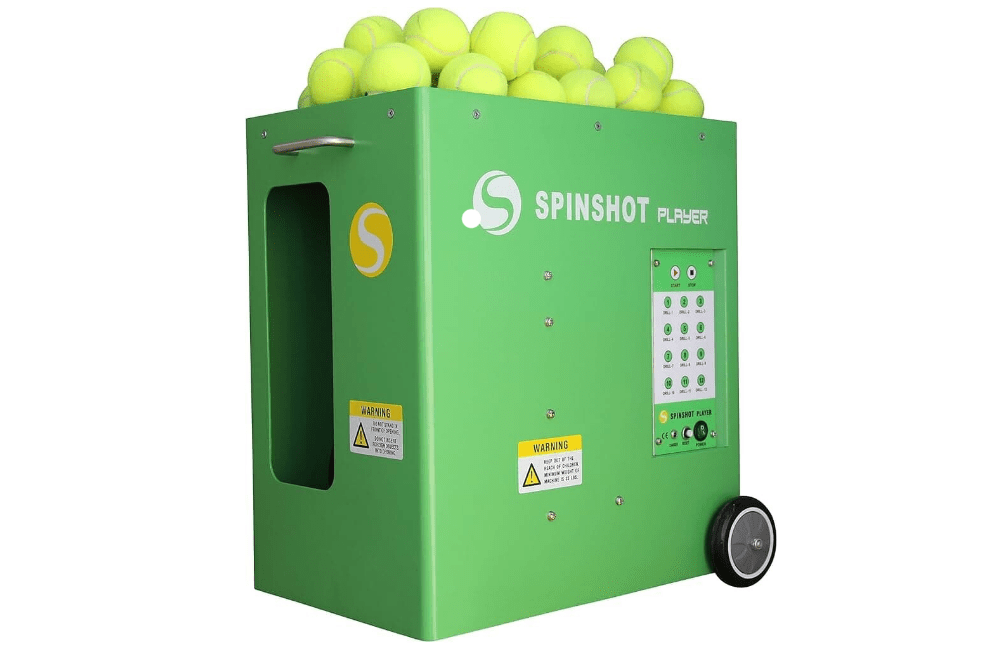
Lobster Sports Elite Grand V Tennis Ball Machine
Lobster Sports’ Elite Grand V series is known for its durability and advanced features. It offers multiple oscillation modes, variable speeds, and spin control. The machine’s large ball capacity and optional remote control make it a favorite among serious players and coaches.
Key Features: Durable construction, advanced oscillation modes, variable speeds, spin control, large ball capacity, optional remote control.
Pros: High-quality build, offers a wide range of features and customization options, suitable for serious players and coaches, consistent performance.
More expensive than other models, may be bulkier and heavier to transport.
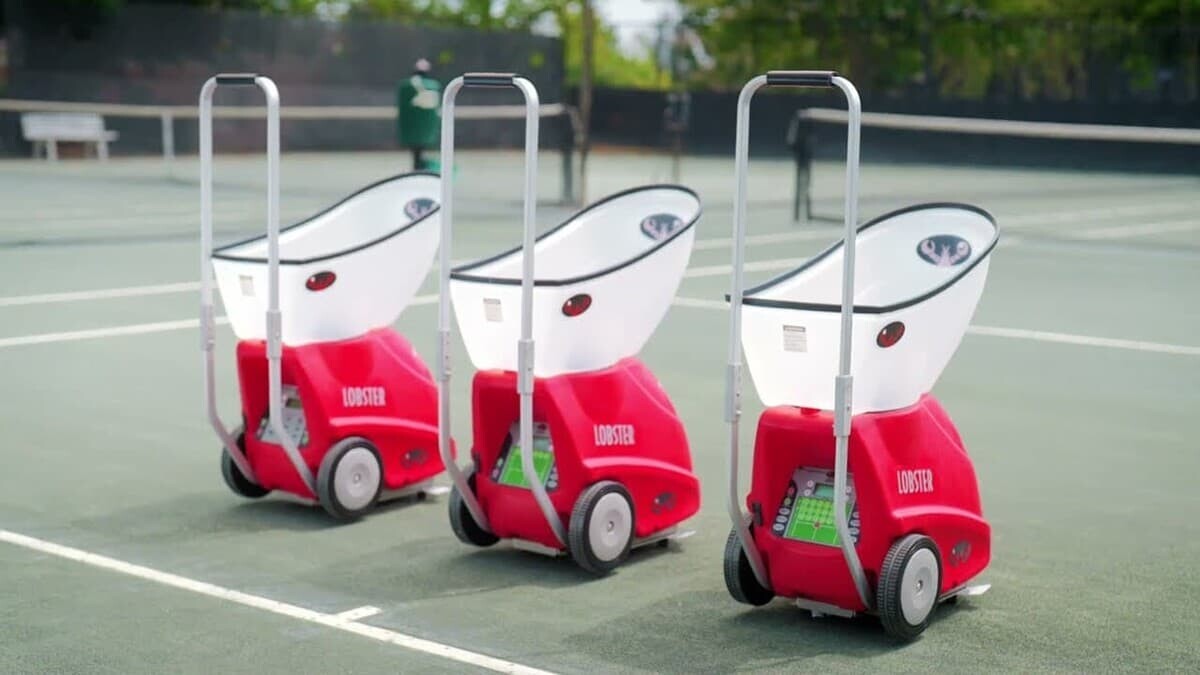
Wilson Portable Tennis Ball Machine
Wilson’s portable tennis ball machine is praised for its affordability and portability. It offers basic features such as adjustable speed, feed rate, and oscillation. While it may lack some advanced functionalities, it’s an excellent entry-level option for beginners and recreational players.
Key Features: Affordable price, portable design, adjustable speed, and feed rate.
Pros: Budget-friendly option for beginners and recreational players, lightweight and easy to transport, straightforward controls.
Cons: Limited features compared to higher-end models may need more advanced functionalities like spin control and programmable drills.
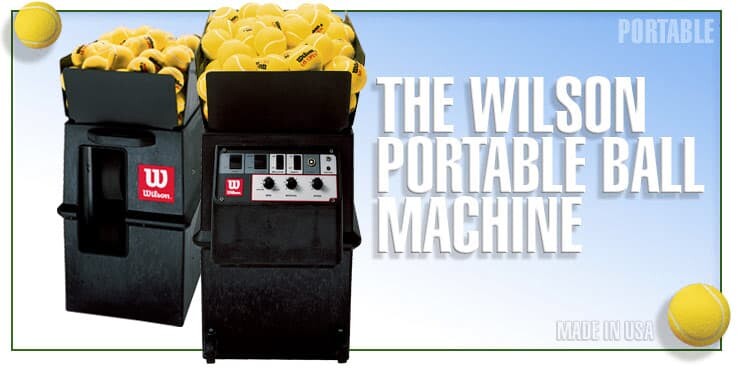
Sports Tutor Tennis Cube
The Tennis Cube by Sports Tutor is known for its simplicity and reliability. It offers straightforward controls and adjustable ball speed, ideal for easy storage and transport.
While it may have fewer features than some higher-end models, it’s a solid choice for casual players and practice sessions.
Key Features: Simple controls, compact size, adjustable ball speed.
Pros: Easy to use, reliable performance, lightweight and portable, suitable for casual players and practice sessions.
Cons: Limited features and customization options may not be suitable for players looking for more advanced functionalities.
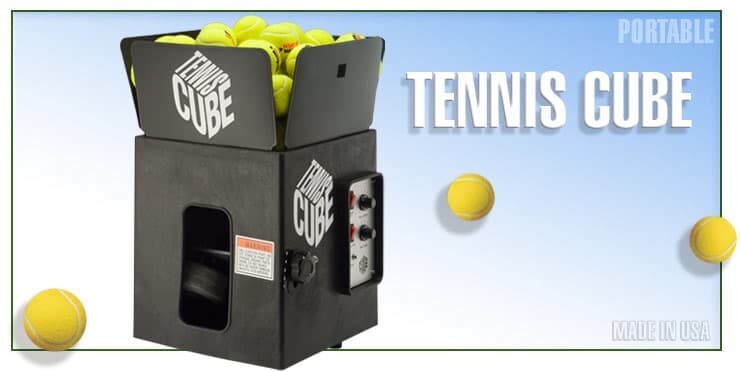
Playmate Genie Tennis Ball Machine
The Playmate Genie is praised for its durability and consistent performance. It offers adjustable ball speed, spin control, and various oscillation modes. While it may be on the higher end in terms of price, its reliability and build quality make it a favorite among serious players and tennis clubs.
Key Features: Durable construction, adjustable ball speed, spin control, and various oscillation modes.
Pros: It offers reliable and consistent performance, is suitable for serious players and tennis clubs, offers realistic practice scenarios, and is built to a high standard.
Cons: Higher price point, maybe heavier and bulkier to transport, may have a learning curve for utilizing all features effectively.

Slinger Bag Tennis Ball Machine
One of the newest tennis ball machines in the market, the Slinger Bag offers a refreshing dose of affordability. In sports, where equipment costs can quickly add up, its competitive price point makes it affordable for players of all levels. The Slinger Bag, with its portability, customization options, and reliability, empowers players to take their game to new heights.
Key features: Lightweight and compact design, various ball speeds, spins and trajectories, battery-powered, remote control.
Pros: Affordable option, simple to use, portability, customization, solo practice.
Cons: Limited ball capacity (around 72 balls), issues with durability, limited programmable drills, irregular ball’s speed or spin.
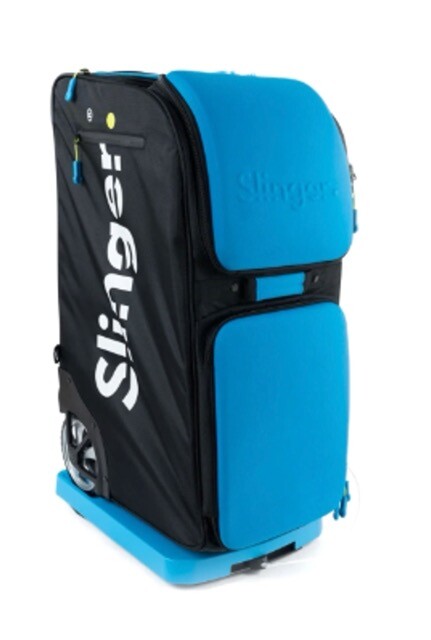
Tips for Using a Tennis Ball Machine
Using a tennis ball machine effectively can help players to improve their skills and consistency on the court. Here are some tips:
- Safety Precautions:
- Keep Your Distance: When the machine is operating, keep a safe distance from it to prevent getting struck by the balls or by any moving parts.
- Secure Court Area: Make sure there are no hazards or impediments in the court area that could affect the machine’s functionality or result in an accident.
- Supervision: Monitor kids or less skilled players using the tennis ball machine to ensure they use it safely and correctly.
- Comply with the manufacturer’s guidelines: To reduce the chance of mishaps, thoroughly read and abide by the manufacturer’s operating instructions and safety guidelines.
- Maximizing Your Practice Sessions:
- Establish Clear Goals: To maximize your time spent using the tennis ball machine, establish clear goals and targets for each practice session.
- Concentrate on Technique: Use the machine to hone your footwork, shot consistency, and technique.
- Create Match Scenarios: Modify the machine’s settings to create a variety of shot kinds, spins, and speeds to replicate game conditions.
- Mix-Up Drills: Mix up the drills and exercises you do to keep your practice session interesting and challenging.
- Remain Mentally Engaged: Approach your practice sessions with the same seriousness and focus as a competitive match.
- Maintaining and Storing Your Tennis Ball Machine:
- Frequent Cleaning: Dust, grime, and debris that may impair the machine’s function should frequently be removed from its exterior.
- Battery Care: If your machine runs on batteries, charge and store them according to the manufacturer’s instructions to extend the battery’s life.
- Storage: To keep the tennis ball machine safe from moisture, high temperatures, and other environmental elements, keep it in a dry, cool area while not in use.
- When the machine is not in use, cover it with a cover or protective case to keep it safe from dust, sunlight, and other potential hazards.
- Check for Damage: Ensure that the machine is routinely checked for signs of deterioration, damage, or malfunction. Resolve any problems immediately to stop more harm and guarantee safe operation.
FAQ
1. What balls are the best for a Tennis Ball Machine?
Pick pressureless tennis balls from reputable manufacturers like Penn or Wilson. They should be brightly colored for maximum visibility. Make sure they fit your machine properly in terms of size and number.
2. What are the fastest ball machines?
Some of the fastest tennis ball machines include the Spinfire Pro 2, Lobster Sports Elite Liberty, and Spinshot Pro.
3. Which lobster ball machine is the best?
This is one of Lobster Sports’ top-of-the-line models. The machine provides sophisticated capabilities, including horizontal and vertical oscillation, variable speeds, spin control, and a large ball capacity. It’s suitable for serious players and coaches looking for a high-performance machine.
Lobster Sports Elite Two:The Elite Two is slightly more affordable than the Grand V but offers many advanced features, including horizontal oscillation, variable speeds, and spin control. It’s a popular choice among players looking for a balance of performance and value.
Lobster Sports Elite Liberty:The Elite Liberty is a more basic model that provides reliable performance with features such as adjustable ball speed and feed rate. It’s a suitable option for recreational players and those on a budget.
Ultimately, the best ball machine for you will depend largely on your personal preferences, level, practice needs, desired features, and specifications.
What is the difference between Lobster Elite 2 and 3?
Variations in Patterns:
- Elite 2: With its horizontal oscillation, the Elite 2 can deliver balls over the width of the court and sweep from side to side. This function allows players to practice hitting shots from various baseline locations.Elite 3:
- The Elite 3 has vertical oscillation and horizontal oscillation, which modifies the height at which the ball is delivered. This function simulates various shot trajectories, such as high lobs and low shots, adding another level of complexity to practice sessions.
Random oscillation:
- Elite 2: Random oscillation is not a feature of the Elite 2.
- Elite 3: The Elite 3 uses a combination of vertical and horizontal oscillation to transport balls across the court unpredictably. This mode mimics the unpredictable character of actual matchplay.
Life of Battery:
Battery power is an option for the Elite 2 and Elite 3, offering practice sessions flexibility and portability. On the other hand, the Elite 3 usually has a longer battery life than the Elite 2, enabling more playback on a single charge.
Cost:
Because the Lobster Elite 3 has more oscillation features and capabilities than the Elite 2, its pricing is generally slightly higher.
To sum up, tennis ball machines are an essential resource for players of all skill levels since they provide a quick and effective means of honing their game. These devices have many characteristics that allow them to imitate different game circumstances and offer focused practice opportunities. These features include adjustable speed, spin control, oscillation, and programmable drills. Investing in a tennis ball machine can help you advance your training, regardless of your skill level. A novice can use it to improve their strokes, and an experienced player can improve their game. Player performance on the tennis court can be improved by selecting the appropriate equipment and carefully weighing features, portability, and cost.